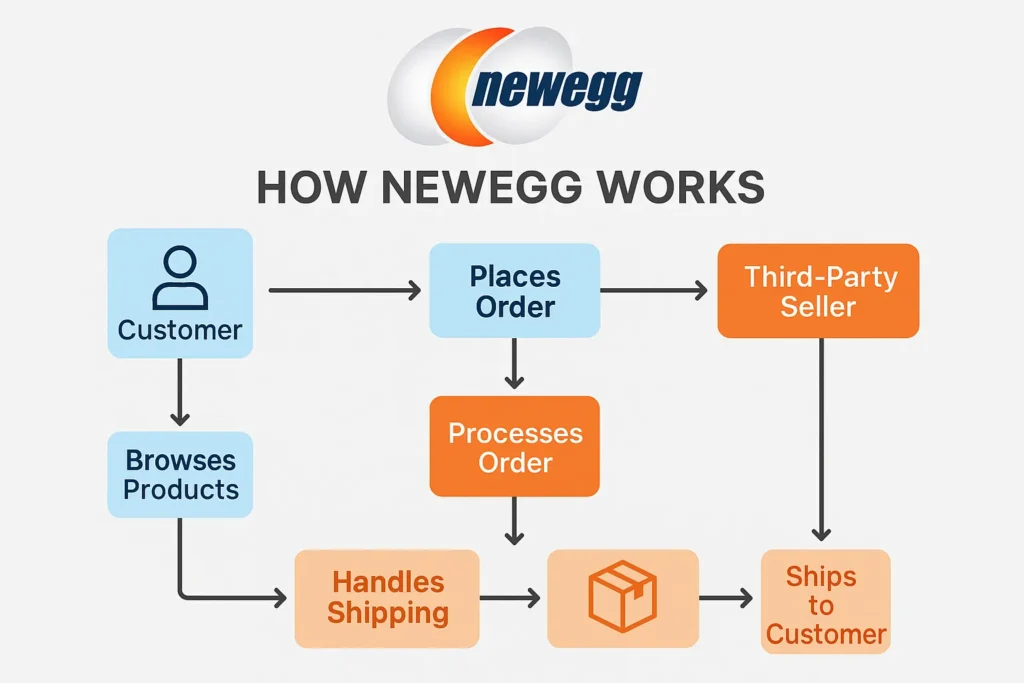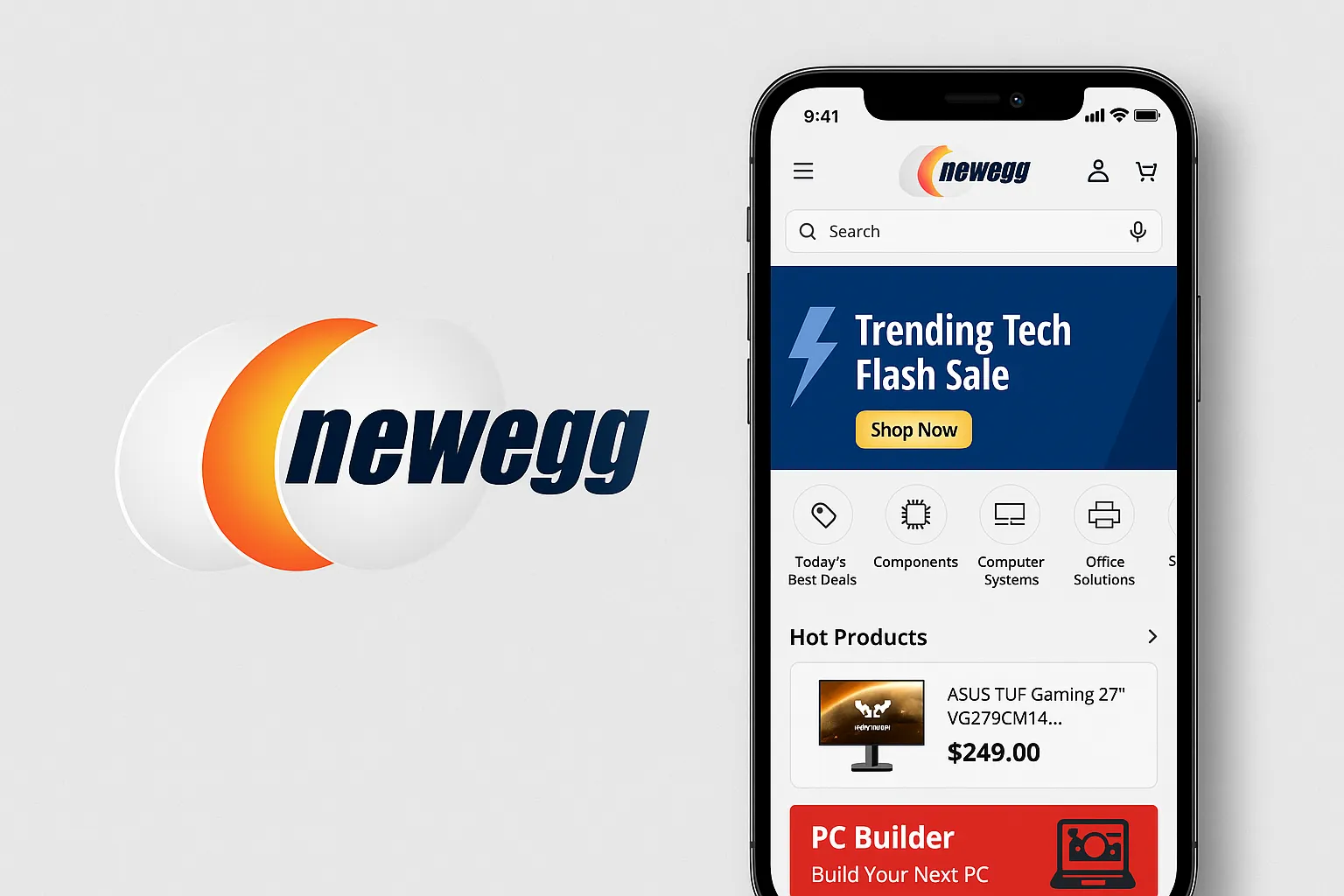Imagine this: you’re building a custom gaming PC—sifting through components, comparing motherboards, graphics cards, RAM. You want a platform that understands you, that specialises in tech, trusts you, and gives you the right deals. That’s exactly where Newegg comes in.
Newegg, founded in 2001 by Fred Chang, started as a U.S.-based online retailer focused on computer hardware and consumer electronics. Over the years it expanded into a full-fledged marketplace, added B2B operations, and diversified product categories. In 2025, Newegg still holds a strong niche among tech-savvy shoppers, and although it faces challenges (such as revenue decline in recent years), its established brand and community remain significant in the e-commerce and tech retail space.
What is Newegg? The Simple Explanation
Newegg is a U.S.-based online marketplace that specializes in consumer electronics, computer hardware, and smart-tech products. Think of it as Amazon for tech enthusiasts — a one-stop platform where users can buy components, gadgets, and accessories directly from verified sellers or Newegg’s own inventory.
It primarily solves the problem of finding reliable, niche electronics — such as GPUs, CPUs, gaming peripherals, and custom PC parts — all in one place, with trustworthy specs, customer reviews, and competitive pricing.
Target Users and Use Cases
- Gamers and PC builders buying components for custom builds
- Tech enthusiasts seeking the latest gadgets
- IT professionals and small businesses sourcing hardware in bulk
- Consumers looking for reliable refurbished electronics
Current Market Position (2025)
- Estimated user base: 30+ million registered customers globally
- Annual revenue (2024): approx. $1.6 billion (down from $2.4 billion in 2022 due to post-pandemic demand shifts)
- Top categories: GPUs, processors, laptops, and gaming accessories
- Global presence: ships to 80+ countries via Newegg Global
Read more: Complete Guide to Starting an E-commerce App Business
Why It Became Successful
Newegg built its reputation on tech-specific expertise, trusted community reviews, and deep product knowledge. Its early focus on hardware enthusiasts gave it an edge in customer loyalty, while modern upgrades like AI-driven recommendations, warehouse automation, and secure payment systems kept it competitive in 2025.
How Does Newegg Work? Step-by-Step Breakdown
For Users (Customers)
- Account Creation
Users sign up using an email or social account. Upon login, they can set preferences for categories (e.g., gaming, hardware, or home electronics). - Product Discovery & Browsing
Newegg’s homepage is built around AI-driven recommendations, trending tech deals, and flash sales. Users can filter by brand, specs, or seller ratings. - Purchasing Process
Add to cart → choose shipping → secure checkout via credit card, PayPal, crypto (yes, Newegg still accepts Bitcoin in 2025), or installment options like Affirm. - Order Fulfillment
Orders are processed through automated fulfillment centers or by third-party sellers. Users can track delivery in real-time through the app. - After-Sales Support
Users can manage returns, warranties, and RMA (Return Merchandise Authorization) directly through the dashboard.
Example:
A gamer building a new rig searches for an RTX 4080 GPU. Newegg suggests compatible motherboards and power supplies, bundles discounts, and shows user-generated “PC Build” videos — all within one interface.
For Sellers / Service Providers
- Onboarding Process
Merchants sign up through Newegg Seller Portal. After verification, they upload product catalogs, set pricing, and choose fulfillment (FBN – Fulfilled by Newegg or Self-Fulfillment). - Operations
Sellers manage inventory, shipping, and customer queries through the unified dashboard. - Earnings & Commissions
- Commission rates: 8–15 %, depending on category
- Optional paid visibility through Newegg Sponsored Ads
- Sellers get paid bi-weekly, post-returns clearance
Technical Overview (Simplified)
Newegg operates on a hybrid marketplace architecture, combining direct sales and third-party listings.
- Frontend: React + Next.js for responsive, fast UI
- Backend: .NET Core + Node.js microservices
- Database: PostgreSQL + Redis caching
- Cloud & Infrastructure: AWS + custom CDN for global reach
- AI Modules: Recommendation engine, fraud detection, and automated pricing

Newegg’s Business Model Explained
Newegg runs on a multi-revenue hybrid eCommerce model, combining direct retail, third-party marketplace commissions, and value-added services for both consumers and sellers. Its focus is tech retail — meaning profit margins are slimmer than fashion or lifestyle eCommerce, but its high-volume and high-value transactions keep it profitable.
How Newegg Makes Money
- Product Sales (Direct Retail)
- Sells electronics and hardware directly from Newegg’s inventory.
- Accounts for around 55 % of total revenue in 2025.
- Marketplace Commissions
- Charges 8–15 % commission on third-party seller transactions.
- Categories like GPUs and laptops yield higher fees due to warranty and logistics handling.
- Fulfillment by Newegg (FBN)
- Sellers can store products in Newegg’s warehouses.
- FBN fees are based on weight and delivery speed (starting at $3.99 per package).
- Advertising & Promoted Listings
- Newegg Sponsored Ads lets sellers pay for top visibility on search results.
- Membership & Subscriptions
- Newegg Premier offers free 3-day shipping, exclusive deals, and extended returns for $49.99/year.
- B2B Solutions
- Newegg Business serves SMBs, schools, and government buyers with bulk deals and dedicated support.
- International Expansion (Newegg Global)
- Cross-border eCommerce model, adding foreign exchange margins and shipping fees.
Revenue Model Breakdown
| Revenue Source | Description | Share (2025 Est.) | Notes |
| Product Sales | Direct sales of hardware/electronics | 55 % | Core business |
| Marketplace Commissions | Seller fee (8–15 %) | 25 % | Growing steadily |
| Fulfillment (FBN) | Warehousing + delivery services | 8 % | Fastest growth segment |
| Advertising | Sponsored listings & brand promos | 5 % | High margin |
| Membership / Premier | Paid customer plans | 3 % | Strong retention |
| B2B Solutions | Bulk & enterprise sales | 4 % | Expanding steadily |
Market Size & Profitability (2025)
- Global electronics eCommerce market: $530 B+
- Newegg U.S. market share: ~2.1 %
- Gross margin: ~13 % (tech retail average)
- Year-on-year digital ad revenue growth: +19 %
Despite increased competition from Amazon, Best Buy, and Micro Center, Newegg’s niche focus + tech-community loyalty continue to sustain its profitability.
Key Features That Make Newegg Successful
Newegg has sustained its edge for over two decades by blending tech expertise, community trust, and modern automation. In 2025, its focus on AI-enhanced shopping, fast fulfillment, and niche targeting continues to differentiate it from broader marketplaces like Amazon or Walmart.
Here are the top 10 features that drive Newegg’s success:
Top 10 Features Explained
- Advanced Product Filtering & Comparison Tools
- Users can compare up to 5 products by specs, price, reviews, and performance benchmarks.
- Crucial for gamers and IT buyers making precision hardware purchases.
- AI-Powered Recommendation Engine
- Suggests compatible components (like pairing a GPU with the right PSU or motherboard).
- Improves conversion rates and user satisfaction.
- Community Reviews & Q&A
- Real-time insights from verified buyers.
- Builds trust and reduces return rates.
- PC Builder Tool
- A signature Newegg feature that lets users design and price custom PCs part-by-part.
- Includes compatibility alerts — an innovation that remains unmatched.
- Flash Sales & Daily Tech Deals
- Rotating discount system backed by predictive analytics.
- Increases engagement and repeat visits.
- Fulfilled by Newegg (FBN)
- Enables third-party sellers to leverage Newegg’s global logistics network.
- Boosts delivery speed and reliability.
- AR/VR Product Previews (2025 Update)
- Shoppers can view PC setups or desk configurations via augmented reality on mobile devices.
- Reduces uncertainty for premium purchases.
- AI Chat & Support Bot “EggBot”
- Handles order tracking, compatibility checks, and troubleshooting in real time.
- Crypto Payments & Installment Plans
- Supports Bitcoin, Ethereum, and Affirm-based split payments.
- Attracts younger and global tech buyers.
- Newegg Premier Membership
- Loyalty program offering early-bird deals, faster shipping, and exclusive access.
Recent 2025 Updates
- New AI-based price-drop alerts integrated with browser extensions.
- GreenTech Initiative: partnerships with eco-certified hardware brands.
- Instant RMA for repeat customers — automated returns under 5 minutes.
AI/ML Integrations
- Predictive pricing engine trained on demand curves.
- Fraud-detection network using behavioral biometrics.
- AI-generated product recommendations and inventory restocking automation.
What Sets Newegg Apart
Newegg’s authenticity in the tech-only segment, paired with AI automation and deep customer data insights, keeps it positioned as the #1 destination for electronics enthusiasts.

The Technology Behind Newegg
Newegg’s digital infrastructure is designed to handle millions of transactions, real-time inventory updates, and global logistics coordination. Its 2025 architecture blends legacy systems with modern microservices and AI-driven personalization to ensure performance, security, and scalability.
Tech Stack Overview (Simplified)
| Layer | Technology Used | Purpose |
| Frontend | React.js + Next.js | Fast, responsive web and app interfaces |
| Backend | .NET Core + Node.js microservices | Modular, scalable system handling millions of products |
| Database | PostgreSQL + MongoDB + Redis | Hybrid structure for structured/unstructured product data |
| Hosting & Cloud | AWS (EC2, S3, CloudFront) | Scalable global delivery and storage |
| AI/ML Modules | TensorFlow, PyTorch | Used for personalization, pricing, and fraud detection |
| Search Engine | ElasticSearch | Instant product search and category filters |
| Payment Gateway | Stripe, PayPal, BitPay | Multi-currency and crypto-compatible checkout |
| Analytics | Google BigQuery + Looker | Real-time dashboards for marketing and performance |
Real-Time Features
- Dynamic Inventory Sync: Product availability updates every few seconds across multiple warehouses.
- Live Price Adjustments: AI monitors competitor pricing and updates Newegg listings dynamically.
- Order Tracking: Integrated with FedEx, UPS, and DHL APIs for real-time delivery updates.
Data Handling & Privacy
- Fully GDPR and CCPA compliant (2025 update).
- Data encrypted at rest (AES-256) and in transit (TLS 1.3).
- Fraud prevention via AI-based pattern recognition and two-factor authentication.
Scalability Approach
Newegg uses a microservices architecture allowing independent scaling of modules like inventory, cart, and payment. During events such as Black Friday Tech Week, it can handle up to 120K transactions per minute with less than 200 ms latency globally.
Mobile App vs Web Platform
- Mobile App (iOS/Android): Optimized for deals, push notifications, and product scanning.
- Web Platform: Offers full builder tools, reviews, and enterprise-level B2B dashboard.
API Integrations
- Seller API: Enables automatic product uploads and price syncing.
- Partner APIs: Integration with logistics, warranty, and finance providers.
- AI Plugins (2025): Third-party developers can build add-ons for analytics and campaign automation.
Why This Tech Matters for Business
This modern tech stack allows Newegg to maintain speed, reliability, and personalization — key ingredients for eCommerce success. Its adoption of AI and distributed microservices ensures 24/7 uptime, faster recommendations, and global reach with minimal operational cost.
Newegg’s Impact & Market Opportunity
Newegg has shaped the online electronics retail industry for over two decades — bridging the gap between tech manufacturers, enthusiast communities, and global buyers. In 2025, its combination of specialized curation, transparent reviews, and AI-driven user experience continues to influence the broader eCommerce landscape.
Industry Disruption Caused
Before Newegg, tech buyers had to rely on multiple fragmented suppliers or generic marketplaces that lacked technical depth.
Newegg disrupted this by offering:
- Comprehensive compatibility data for every product.
- User-driven validation (Q&A and verified purchase reviews).
- Direct B2B sourcing with transparent warranty handling.
This specialization made Newegg a trusted authority among tech professionals — similar to how AutoTrader dominates cars or Zillow dominates real estate.
Market Statistics & Growth
| Metric | 2022 | 2024 | 2025 (Est.) |
| Global users | 25 M | 30 M | 33 M + |
| Annual revenue | $2.4 B | $1.6 B | $1.8 B |
| Active sellers | 18 K | 20 K | 22 K |
| Conversion rate | 3.8 % | 4.1 % | 4.5 % |
| Avg. order value | $220 | $240 | $265 |
Despite a dip in post-pandemic electronics demand, Newegg remains among the top 3 tech-focused marketplaces in North America, maintaining healthy community engagement and global reach.
User Demographics & Behavior
- Age group: 18 – 44 yrs (core: 25 – 34 yrs tech-savvy users)
- Gender split: 82 % male, 18 % female (2025 analytics show slow diversification)
- Average visit time: 6 + minutes per session — 2× higher than mainstream retailers
- Popular categories: GPUs, SSDs, gaming monitors, smart-home kits
Geographic Presence
- Headquarters: City of Industry, California
- Primary markets: U.S., Canada, UK, Australia, India (emerging)
- Newegg Global enables sellers from 50 + countries to list and ship internationally, expanding market share beyond the U.S.
Future Projections (2025 – 2027)
- Global tech-hardware eCommerce expected to grow at 9 % CAGR.
- Newegg investing in AI-driven logistics and green packaging automation.
- Potential expansion into IoT marketplaces (smart-home devices, EV accessories).
- AR-based virtual PC-build showroom in beta for 2026 launch.
Opportunities for Entrepreneurs
The “niche-first marketplace” model Newegg pioneered proves that specialized verticals can thrive even in Amazon’s shadow.
Entrepreneurs can build clone platforms for other verticals — for example:
- Gaming gear marketplaces
- Drone-parts and robotics components
- Smart-home electronics portals
- B2B IT hardware sourcing hubs
Building Your Own Newegg-Like Platform
The success of Newegg proves that niche-driven marketplaces can outperform generic eCommerce platforms when built with expertise, trust, and technology focus. For entrepreneurs, creating a Newegg-like electronics marketplace offers immense opportunity in 2025 and beyond — especially with the global rise of tech buyers and DIY hardware enthusiasts.
Why Businesses Want Newegg Clones
- To tap into the electronics and gadget retail boom without competing directly with Amazon.
- To build authority in specialized niches like gaming PCs, robotics, or IoT devices.
- To leverage AI, personalization, and automation for better customer experiences.
- To connect manufacturers and consumers in a transparent, review-based ecosystem.
Key Considerations for Development
- Focus on a Specific Niche: Start narrow (e.g., gaming components, refurbished tech).
- Scalable Architecture: Adopt a modular backend (Node.js or Laravel + React).
- User Trust Tools: Verified reviews, warranties, and clear return policies.
- AI Features: Personalized recommendations, real-time price tracking, and compatibility checkers.
- Logistics & Payment Integrations: Multi-vendor fulfillment, crypto support, and local currency handling.
- Regulatory Compliance: GDPR, PCI-DSS, and ISO 27001 readiness.
Time and Cost Factors
| Development Stage | Timeline | Cost Range (USD) |
| Discovery & Planning | 1-2 weeks | $500 – $1,000 |
| UI/UX Design | 1-2 weeks | $700 – $1,200 |
| Backend + API Development | 3-4 weeks | $1,200 – $2,000 |
| Mobile App (iOS + Android) | 2-3 weeks | $1,000 – $1,800 |
| Testing & Launch | 1 week | $400 – $700 |
| Total Estimated Range | 6-10 weeks | $3,000 – $5,000 |
Essential Features to Include
- Multi-vendor dashboard
- Real-time inventory sync
- Product comparison system
- Advanced filters and search
- AI recommendations & chatbots
- Crypto / global payments
- Fulfillment tracking
- Admin analytics dashboard
Read more: How to Market an e-commerce app Successfully After Launch
Conclusion
Newegg’s journey from a niche computer parts retailer to a global tech marketplace is a masterclass in how focus, community trust, and technology can create lasting success. In 2025, it remains a top destination for gamers, IT professionals, and hardware enthusiasts — not just because of its vast catalog, but because it understands its audience better than any generalist platform.
Its combination of AI-powered personalization, robust seller ecosystem, and transparent review system makes it a model worth emulating. And as more entrepreneurs look to tap into specialized eCommerce niches, Newegg’s hybrid marketplace structure provides a proven blueprint for success.
If you’ve ever dreamed of building your own platform that connects tech buyers and sellers — one that’s fast, secure, and future-ready — now’s the time.
Ready to Build Your Own Newegg-Style Platform? Transform your eCommerce idea into reality with Miracuves. Contact Us to get a free project consultation today
FAQs
Q:1 How does Newegg make money?
Newegg earns through direct product sales, marketplace commissions (8–15%), Fulfilled by Newegg (FBN) logistics, advertising placements, and premium memberships (Newegg Premier).
Q:2 Is Newegg available in my country?
Yes. Newegg ships to over 80 countries worldwide through its Newegg Global program, covering North America, Europe, Asia-Pacific, and select parts of the Middle East.
Q:3 How much does Newegg charge users?
Using Newegg is free for buyers. You only pay for products, taxes, and shipping. Subscription services like Newegg Premier cost $49.99/year for benefits like faster shipping and early deals.
Q:4 What’s the commission for sellers or service providers?
Sellers are charged 8–15% commission, depending on product category. Additional fees apply for FBN warehousing or advertising.
Q:5 How does Newegg ensure safety and trust?
Newegg uses AI fraud detection, buyer protection policies, verified seller programs, and secure checkout (SSL/TLS 1.3). Returns and RMAs are managed directly through the platform.
Q:6 Can I build something similar to Newegg?
Absolutely. With platforms like Miracuves, you can build your own Newegg-style marketplace in just 3-6 days, featuring vendor dashboards, AI-powered recommendations, and crypto-ready checkout.
Q:7 What makes Newegg different from competitors?
Unlike Amazon or Best Buy, Newegg specializes exclusively in technology and electronics, offering deep compatibility data, custom PC builder tools, and a community-driven review system.
Q:8 How many users does Newegg have?
As of 2025, Newegg has over 33 million active users and more than 22,000 sellers worldwide.
Q:9 What technology does Newegg use?
Its tech stack includes React, .NET Core, Node.js, PostgreSQL, Redis, AWS, TensorFlow, and ElasticSearch, powering real-time pricing, AI recommendations, and secure global transactions.
Q:10 How can I create an app like Newegg?
You can develop a Newegg-like app using Miracuves’ eCommerce marketplace clone script, which comes with multi-vendor support, AI recommendations, and secure global payments — Go Live in just 3-6 days.
Related Articles:







